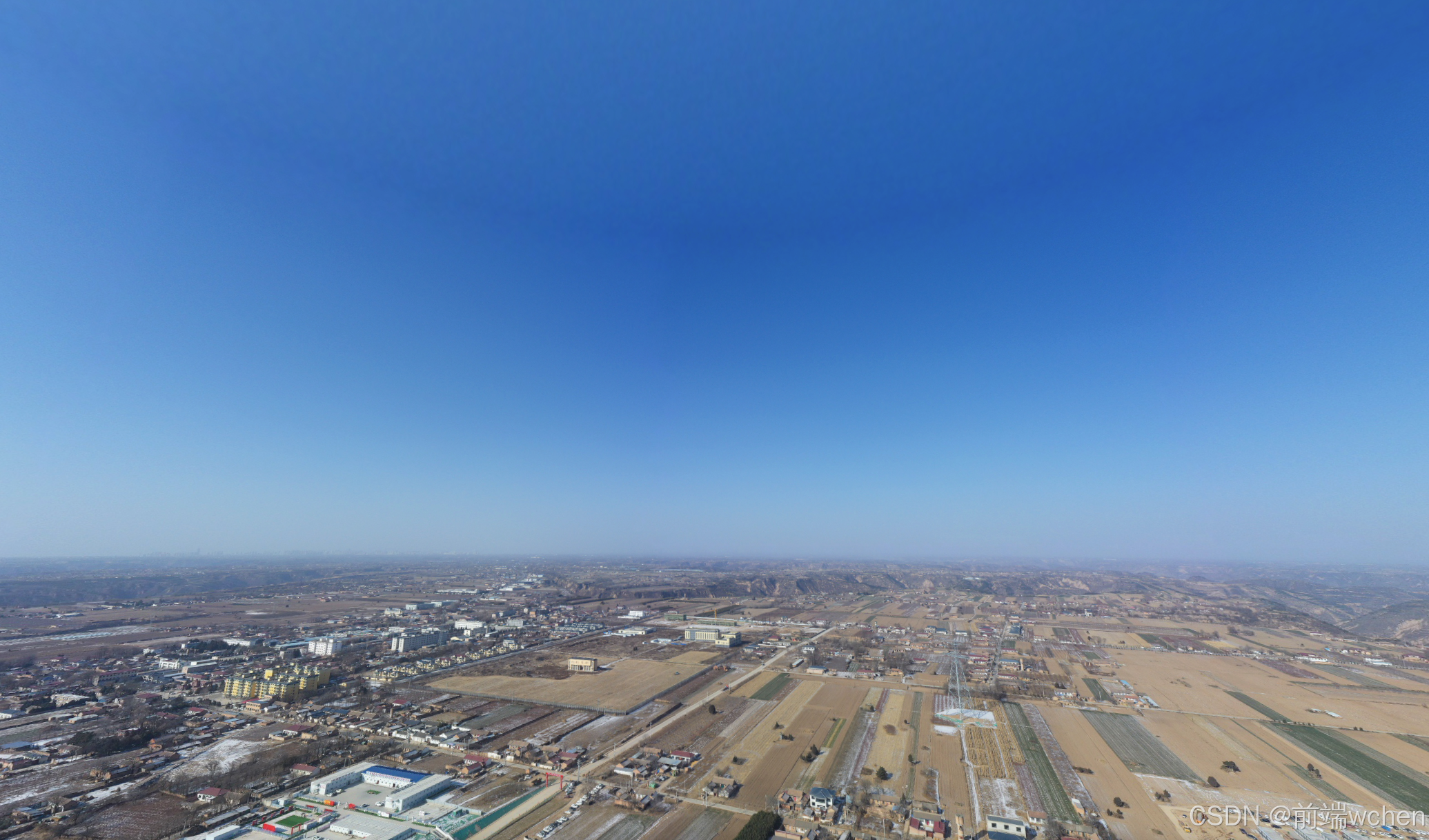Vue2 + Three.js 创建可交互的360度全景视图,可控制旋转、缩放
引言
在现代网页开发中,三维图形技术已经成为提升用户体验的重要工具。本文将展示如何使用 Three.js 创建一个简单的可交互360度全景视图。通过这一项目,你将能够学习到基本的场景设置、相机控制以及用户交互的实现方式。
效果展示

环境准备
首先,你需要在项目中引入 Three.js。可以通过 npm 安装:
npm install three
确保你的项目结构中有一个名为 images 的文件夹,并放入一张全景图像(如 001.jpg),以便后续使用。
代码示例
下面是实现可交互360度全景视图的 Vue.js 组件代码:
<template>
<div class="c-width c-height" id="containerVr"></div>
</template>
<script>
import * as THREE from 'three';
import PANO0001 from './images/001.jpg';
export default {
name: 'containerVr',
data() {
return {
scene: null,
camera: null,
renderer: null,
};
},
mounted() {
this.init();
},
methods: {
init(img) {
img = img ? img : PANO0001;
const containerVr = document.getElementById('containerVr');
containerVr.innerHTML = '';
// 初始化用户交互变量
let isUserInteracting = false,
onPointerDownMouseX = 0, onPointerDownMouseY = 0,
lon = 0, onPointerDownLon = 0,
lat = 0, onPointerDownLat = 0,
phi = 0, theta = 0;
// 创建相机对象
const camera = new THREE.PerspectiveCamera(75, window.innerWidth / window.innerHeight, 1, 1100);
// 创建场景对象
const scene = new THREE.Scene();
// 创建球体几何体,表示全景图的表面
const geometry = new THREE.SphereGeometry(500, 60, 40);
geometry.scale(-1, 1, 1);
// 加载并设置全景图纹理
const texture = new THREE.TextureLoader().load(img);
texture.colorSpace = THREE.SRGBColorSpace;
const material = new THREE.MeshBasicMaterial({ map: texture });
// 创建网格对象,将几何体和材质结合
const mesh = new THREE.Mesh(geometry, material);
scene.add(mesh);
// 创建渲染器并设置参数
const renderer = new THREE.WebGLRenderer();
renderer.setSize(window.innerWidth, window.innerHeight);
renderer.setPixelRatio(window.devicePixelRatio);
// 将渲染器的DOM元素添加到容器中
containerVr.appendChild(renderer.domElement);
containerVr.style.touchAction = 'none';
// 添加事件监听器以处理用户交互
containerVr.addEventListener('pointerdown', onPointerDown);
document.addEventListener('wheel', onDocumentMouseWheel);
// 窗口大小调整事件
window.addEventListener('resize', onWindowResize);
function onWindowResize() {
camera.aspect = window.innerWidth / window.innerHeight;
camera.updateProjectionMatrix();
renderer.setSize(window.innerWidth, window.innerHeight);
}
// Pointer Down事件处理
function onPointerDown(event) {
if (event.isPrimary === false) return;
isUserInteracting = true;
onPointerDownMouseX = event.clientX;
onPointerDownMouseY = event.clientY;
onPointerDownLon = lon;
onPointerDownLat = lat;
document.addEventListener('pointermove', onPointerMove);
document.addEventListener('pointerup', onPointerUp);
}
// Pointer Move事件处理
function onPointerMove(event) {
if (event.isPrimary === false) return;
lon = (onPointerDownMouseX - event.clientX) * 0.1 + onPointerDownLon;
lat = (event.clientY - onPointerDownMouseY) * 0.1 + onPointerDownLat;
}
// Pointer Up事件处理
function onPointerUp() {
if (event.isPrimary === false) return;
isUserInteracting = false;
document.removeEventListener('pointermove', onPointerMove);
document.removeEventListener('pointerup', onPointerUp);
}
// 滚轮事件处理
function onDocumentMouseWheel(event) {
if (event.toElement.getAttribute('data-engine') && event.toElement.getAttribute('data-engine').indexOf('three.js') > -1) {
const fov = camera.fov + event.deltaY * 0.05;
camera.fov = THREE.MathUtils.clamp(fov, 10, 75);
camera.updateProjectionMatrix();
}
}
// 动画循环
function animate() {
requestAnimationFrame(animate);
update();
}
// 更新函数,处理相机位置和渲染
function update() {
if (isUserInteracting === false) {
lon += 0.02;
}
lat = Math.max(-85, Math.min(85, lat));
phi = THREE.MathUtils.degToRad(90 - lat);
theta = THREE.MathUtils.degToRad(lon);
const x = 500 * Math.sin(phi) * Math.cos(theta);
const y = 500 * Math.cos(phi);
const z = 500 * Math.sin(phi) * Math.sin(theta);
camera.lookAt(x, y, z);
renderer.render(scene, camera);
}
animate();
},
// 设置图像的方法
setImg(url) {
let loader = new THREE.TextureLoader();
let texture = loader.load(url);
let material = new THREE.MeshBasicMaterial({
map: texture,
side: THREE.DoubleSide
});
return material;
},
}
}
</script>
<style scoped>
#containerVr {
width: 100% !important;
flex: 1 !important;
}
#containerVr >>> canvas {
max-width: 100%;
max-height: 100%;
}
</style>
代码解析
- 组件结构:该组件使用 Vue.js 的
<template>、<script>和<style>标签组织代码。 - 初始化方法:在
mounted钩子中调用init方法,初始化 Three.js 的场景、相机和渲染器。 - 用户交互:实现了鼠标按下、移动和滚动事件,用户可以通过拖动鼠标来旋转视图。
- 自适应窗口:通过监听窗口大小变化事件,动态更新相机和渲染器的尺寸。
总结
通过本文,你可以学习如何使用 Three.js 创建一个基础的360度全景视图。这种技术可以广泛应用于虚拟现实、在线展示以及游戏开发等多个领域。希望这篇文章对你理解 Three.js 和创建互动场景有所帮助。
进一步学习
通过这种方式,读者不仅可以理解代码的具体实现,还能了解到如何在实际项目中应用这些技术。希望这个结构能帮助你更好地撰写博客!如果你有其他想法或需要进一步的帮助,请告诉我。



























 1835
1835

 被折叠的 条评论
为什么被折叠?
被折叠的 条评论
为什么被折叠?










